Ground Transit Evolves with Advanced Interconnect Products
From light rail to school buses, advanced interconnects are enabling cities to relieve traffic congestion, reduce pollution, drive economic growth, and modernize our transit systems.
Public transit is changing. A new generation of vehicles is joining our transportation networks to provide expanded service, meet pollution reduction goals, and connect growing city centers with the surrounding communities. While the U.S. continues to be the land of the automobile, city growth and road congestion, combined with a greater preference among Millennials for commuting via mass transit, are prompting expansions of mass transit systems. Light rail, upgraded rail cars, and next-generation buses are becoming part of the picture in many U.S. cities. These newer vehicles emphasize various types of electronic systems and provide new opportunities for connector companies to innovate as the transportation grid modernizes.
Although the recently proposed U.S. federal budget has a first-year 13% reduction (from prior fiscal 2017 $18.6 billion) for the Department of Transportation’s budget, which essentially ends subsidies to Amtrak and reduces capital for new major transit projects, most of the publicly funded projects currently underway will continue. Business economics and consumer demand are stimulating upgrades and replacements for older buses, rail cars, and commercial transports.
New equipment sales for fixed rail, subways, and upgraded light rail commuter trains are significant. According to a recent study published by the U.S. Department of Commerce, this segment has climbed by nearly 20% to over 20,000 trainsets. While light rail equipment purchases will have good growth, modern streetcars and bus rapid transit systems (BRTS) present potential opportunities for manufacturers of both specialized and industry-standard connectors.
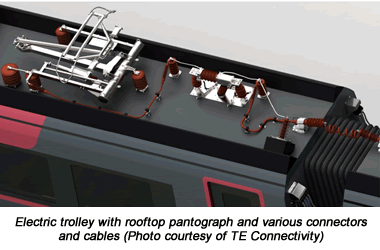
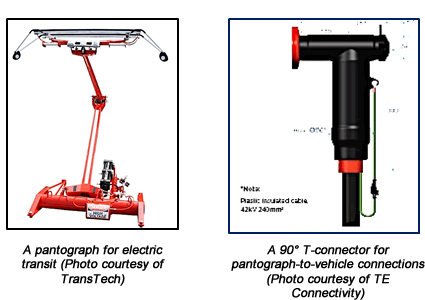
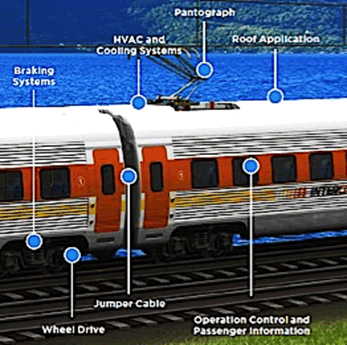
Trains offer multiple application areas for connectors. (Photo courtesy of TE Connectivity)
Intercity rail transport also is expanding. The National Railroad Passenger Corporation, doing business as Amtrak (a combination of the words “America” and “track”), handles most passenger traffic. The U.S. government established Amtrak in 1970 with the Rail Passenger Service Act, which was passed following the bankruptcy of Penn Central, the last major privately owned passenger railroad in the country. Over the last two decades, Amtrak’s ridership has increased by 50% to over 30 million a year, with approximately one-third of that use in the Northeast Corridor (NEC) between Washington D.C., New York City, and Boston. Another 15 million passengers use local commuter and intercity trains in heavily populated regions such as Chicago and California. Since many of Amtrak’s cars date back to the 1980s and were produced by the Budd Company, which filed for bankruptcy in 2014, these sustained increases in ridership present good growth opportunities for new equipment.
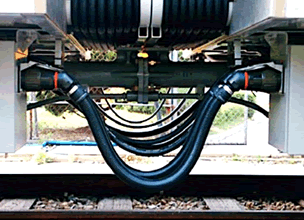
Between-car cabling uses reverse bayonet connectors per VG95234 specifications. (Photo courtesy of Amphenol-Air LB GmbH)
In addition to hardware potentials for new equipment, recent changes to public transit use, funding, and goals will affect other technology and business areas. For instance, consumer demand for improved efficiency and cost reduction will generate requirements for advanced system management and fleet management tools, including real-time diagnostics for accident prevention and maintenance. The automotive concept of connected vehicles will also evolve to include passenger rail cars and commercial buses with online ticketing, transfers, and related data, which will add to both the expansion and challenges associated with future 5G networks and latency problems involved with two-way cloud computing (e.g., the real-time needs of vehicle sensors). Further, economics will stimulate regional cooperation to coordinate feeder lines for populated areas, resulting in transportation hubs that will generate additional economic activity (e.g., food courts, shops, etc.).
Buses are Ideal for Electric Drives
Electric drives offer many advantages over diesel-fueled counterparts, including pollution reductions, quieter operation, reduced maintenance, and total fuel-cost savings. Over the past 20 years, new vehicle purchases have emphasized light-duty cars and smaller buses with hybrid- and all-electric technologies. Today, though, higher growth is occurring for medium- and heavy-duty vehicles. Electric drive buses greatly reduce carbon greenhouse gas (GHG) emissions, as well as particulate matter and smog, which is an especially important issue for urban areas. For example, California’s rules that prohibit delivery truck drivers from keeping their engines running while standing have been used to justify the use of plug-in hybrid armored cars since 2016.
Buses usually have fixed routes and schedules, which enables planners to accurately predict energy use and makes them ideal for hybrid- and all-electric operations. It is estimated that hybrid electric vehicles (HEV) accounted for 40% of all new transit buses purchased in North America in 2016.
Plug-in hybrid electric vehicles (PHEVs) are similar to HEVs. However, PHEVs possess additional energy storage capabilities and can recharge using external power supplies. Depending on the route, plug-in hybrid-electric buses can deliver a 25–50% fuel economy improvement over traditional buses with internal combustion engines (ICEs).
PHEVs contain both an ICE and an electric motor, which are independently connected to the transmission, but can power it collaboratively or independently. Their batteries can be recharged via regenerative braking or through a connection to the electric power grid.
All-electric vehicles (EVs) use only electric motors, have no onboard ICE, and must be plugged into an external power source to be recharged. The technology for EV buses is less mature than that for HEV systems, but offers additional benefits, including zero tailpipe emissions, low-noise operation, lighter-weight and potentially even lower-cost vehicles.
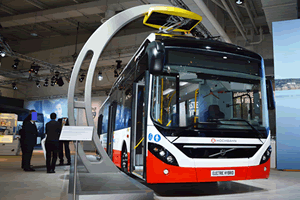
Projected growth includes rapid-charging electric vehicles, including buses and commercial vehicles. This Volvo 7900 electric hybrid bus utilizes a pantograph fast-charging system.
Most of today’s EV buses are compatible with AC charging, and recharge via 120 or 208/240VAC outlets. For higher-speed charging, DC fast-charging equipment is required. As expected, several manufacturers are developing DC fast-charge plug-in systems that utilize heavy-duty connectors and cables similar to those employed in railroad applications. Electric bus manufacturer Proterra has developed the FastFill™ Charging Station, which can charge a bus with a 40-mile range in about 10 minutes. Charging stations positioned at bus stops offer a rapid and convenient method for charging bus fleets, intra-city delivery vehicles, and other vehicles that travel within limited or predictable distances.
The global market for electric drive buses is expected to expand with a projected compound annual growth rate (CAGR) of 26.4% from 2012 through 2018 (Jerram & Gartner, 2012).
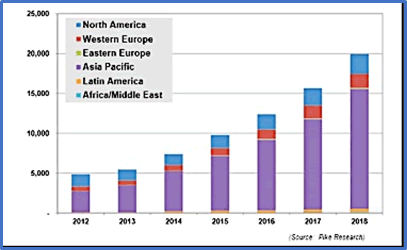
For the foreseeable future, sales of all electric and hybrid electric vehicles will rely on new technologies that will help improve city environments, add to economic growth, and enable a seismic change in our transportation patterns.
Recently posted:
[related_posts limit=”10″]
- New Circular Connectors Add to Multi-Billion Dollar Market - January 9, 2024
- Counterfeit Components Ground Airlines - December 12, 2023
- Cables, Connectors, Waveguides, and Hybrid Products for up to THz at IMS 2023 - July 11, 2023






